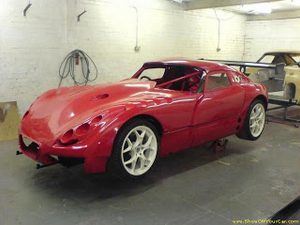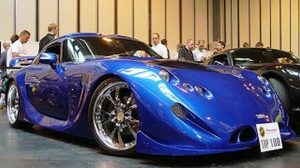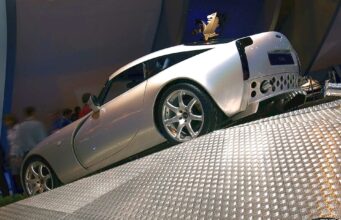
The matter is: “Is a TVR always a TVR, as long as it has a TVR shaped body?“. Would a Ferrari with a Porsche engine, be a Ferrari? Obviously we don’t think so. Despite this we already covered some “strange” situations: a TVR Cerbera with a LS1 Corvette engine and a TVR Sagaris with a LS7 Corvette engine. But there are also some interesting matters: can we consider TVR 5000Ms and Griffiths real TVR? After all engines weren’t installed at Blackpool plant. Similar questions: what about the Bentley EXP8? Is it a Bentley or an Audi R8?
Enthusiasts give very different answers. There’s who says “TVR = looks + sound + speed……. if it has those regardless of whats been done to it then its a TVR“. So it seems it’s a matter of physical feelings. Again a similar opinion: “In the future I would imagine that LS engined conversions or similar will be worth less than an original car but they well be viewed as ‘period’ conversions and of interest to enthusiasts and still worthy of being called a TVR as it’s still 75% or more as it came from Blackpool“.
There’s who’s very practical: “I agree that a number of cars should be kept original and looked after to preserve heritage as you say but i believe TVRs were designed to be driven and were also designed as improvements over previous models and its a natural move by most owners to improve and modify on their pride and joys“.
AND WHAT ABOUT RACE CARS?
Thoughts are positive towards the possibility to build “shaped” TVRs. There’s who thinks that “Race cars are again different like the race Sagaris as they stand are evolutions of the TVR shape and in many cases at the moment the underpinnings as well. Usually the teams and people building & running them have a TVR history and so there is a genuine continuity there which still makes them a TVR imo. Down the line when it’s a fibreglass ‘TVRish’ shell on a folded alloy or pure carbon tub with no Blackpool connections then it just becomes a silouette with no real TVR DNA, much like the ‘Lotus’ team in F1 which imo is just a cynical marketing move “. Or: “if I were holding the rights to the TVR brand I would have no hesitiation to license these as bona fide TVRs – just like the Eurotech-built Marcoses kept the brand alive even though in the end only the front and rear screens were identical to the road cars, and no roadgoing cars had been built for a long while“.
THE PURISTS
Of course there are the talibans: “when you start to exchange engines, borrow parts from other manufacturers, the car is no longer a true TVR, and becomes more and more a kit car. I know this will be a deeply unpopular view, but you wouldn’t fit a corvette engine to a Ferrari, or a Porker“. Another interesting point of view: “I am a bit of a purist and think, persoanlly, the engine changes render the converted cars no more than kit cars. The race Sags that have been built, sorry, not TVRs, and not Sagaris – modified body, wrong engine and gearbox, different chassis…Work of art YES, TVR NO, not for me“.
THE PROBLEM OF VALUE
There’s an important question: a modified car would surely better but there could be serious problem with VIN numbers and most of all, values: Which are worth more now….Triumph Stags with the original V8 or those that have a Rover V8 conversion..? Totally understand why it was done but which is now deemed to be more valuable? The other thing was the often mentioned ‘matching numbers’…assume this is reference to chassis, engine, etc numbers….if these are changed ‘in the future’ will non-matching numbers impact on the value..? I personally would like the cars to be original but understand why they are changed. The LS engined Cerbs seem to be awesome!“.
WHAT MAKES A TVR A TVR?
“I think ALL modification however big or small can be grouped together (you’ve changed it from original) and as long as they are sympathetic to the original maker, are all exceptable. This is kinda how I justify an LS in a TVR where I wouldn’t put one in a Ferrari. Ferrari don’t make big bruiser V8 power houses but this is essentially TVR IMO. Yes, an AJP is more akin to a Ferrai V8 than a Rover V8 so I’ve changed the Cerb character, but IMO thats where TVR started to go wrong I made mine as a cousin to the best days of Chim’s and Griff’s. So maybe the question should firstly be, What makes a TVR a TVR??? For me, I think the OP described it rather well.Values wise I think LS cars will sit nicely against their purer cousins, I like to think if I ever sold mine, it might claw back an original prospective TVR purchaser who may have have gotten cold feet and gone for the Porsche option instead“. And apart from the engine: “If a TVR is not a TVR because it has a Chevy engine, then the same rationale can be applied to non-standard, shocks, wheels, clutches etc, etc. It’s a TVR if you want it to be and certainly no less of a car if you want to change/upgrade it in any way“.
FOUR AREAS
Let’s get a conclusion in order to try to clarify the matter:
1) Original unmolested factory cars – will be the highest value residuals
2) Upgraded road cars – may enhance the performance/handling/reliability, and are often seen as the ones to go for by those who drive the cars more enthusiastcally and often. Values are similar though £000s have been spent.
3) Modified road cars – We are taking proper modified here, engine transplants, ecu changes, profile and look changes etc. These but will USUALLY fetch at best similar residuals but are harder to sell. But as TVR prices seem to have stabilised now the Factory closure is old news and the independant infrastructure is set, more newbies will come to the fold looking for and used to “modified” cars. Again £s spent are usually not recovered. Done for love.
4) Race cars. The same 3 above apply really, except that in racing, Team development is par for the course and so values often go with the modifications so long as they conform to series regs. Loads of examples of adding value with cost/performance the most notable to my mind being the Shelby Cobras. Enhanced looks, performance and pedigree. I see the GTFs in that vane. The latest GT1 spec GTFs will be around £130K but will be up against £300k Moslers.
























An intersting article which reminded me of the case of Hubbard v Middlebridge Scimitar Ltd (1990) High Court in which Otton J had to decide whether the Bentley Speed 6 which it had been agreed would be purchased really was "Old Number One" In his judgment he gave an outline of what had happened to "Old Number One" as it gradually came to include significant parts from other cars. In this particular case he held that it was still "Old Number One" notwithstanding that it had now had other components from various other cars. So it was worth considerably moore than if it had not been "Old Number One." Of course circa 1929 Bentley's people never thought that particular cars would become historically important, and therefore valuable. What are the prospects for such as TVR circa 2060?